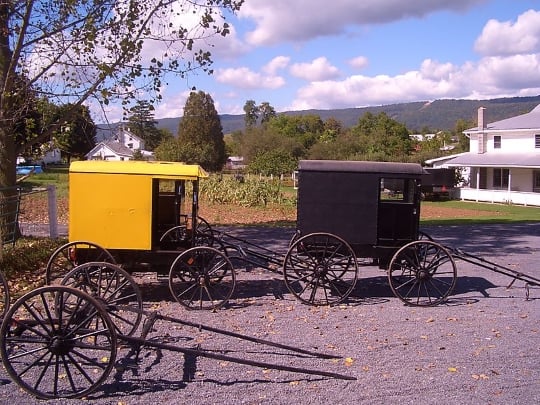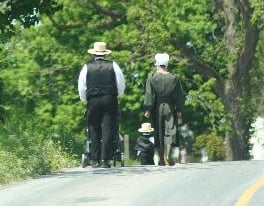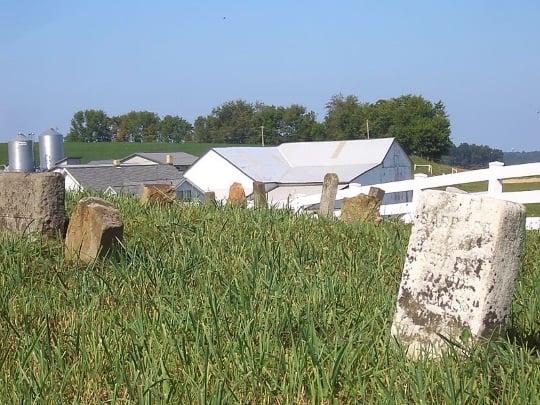2013 Amish Conference: An Amishman on the Ordnung
On Saturday morning at the Amish technology conference, an Amish speaker gave a short talk on the Ordnung, key to the discussion of the Amish relationship to technology.
I was presenting at the time so was not able to hear it in person. However I was able to acquire a copy of the talk, entitled “A reflection on the nature of Ordnung and why it changes”. I’m sharing it here with the speaker’s blessing.
It should be noted that this is a personal exposition on the Ordnung, and was delivered by an Old Order Amishman from Lancaster County.
—
A reflection on the nature of Ordnung and why it changes
Amish life is governed by a set of oral guidelines for expected behavior and principles known as the Ordnung which is a German word meaning rules, regulations, and order.
By applying the principles of the New Testament to daily life, this unwritten code regulates the private, public, and ceremonial behavior of the community.
The Ordnung is the way that we decide what products and practices would weaken morality and meaningful communal life and which would strengthen it.
It is a blueprint of collective wisdom that governs what is considered to be moral for the individual and necessary for the survival of the community.
And although I prefer the phrase deliberate marginality, separation from the world is a key principle of the Amish way of life. The world along with the dark side of human nature which resides within every human being is perceived to be corrupted by vanity and vice, greed, violence and lust. That said there are some Amish who are more worldly than the people of the world.
Therefore, the necessity of being different from the outside culture guides a lot of thinking and decision-making. This along with ideas of taking up cross and following Jesus being a light to the world and the salt of the earth, plus expecting to suffer for these efforts, are the impetus for decision-making.
In the ever-changing landscape of modern life, it often becomes a problem in deciding what modern innovations strengthen the community and which weaken it. Or, if using a new labor-saving technology would enrich the Amish lifestyle or corrupt it.
One of the things the Amish still do while trying to decide is assume that faith, tradition, family, church and community are often sources of wisdom more than agents of oppression. The degree to which this is assumed is in my humble opinion one of the distinctives of our culture. Faith, tradition and church are most of the time not seen as impositions on our freedoms but rather as expressions of our social and communal nature.
Charles Colsom talks about shalom, the Hebrew word for peace. He refers to shalom as peace in a positive sense, with much broader connotations than simply the absence of hostilities. He means it is a state of well-being.
He captures this very well when he says that, when people live together according to God’s moral order—in shalom—there is civility and harmony.
He continues that we are inherently communal beings. Indeed we are created in the image of the One who in his very essence is a community of being—that is the Trinity.
Rick Warren talks about Worship not being for our benefit but a service to the Creator. So it is in a very real sense with Ordnung. It really isn’t for our benefit, rather it is an act of service to the Creator.
In Ephesians it says it should be our goal to present the church to Christ as a radiant church, without stain or wrinkle or any other blemish, but holy and blameless.
The ideals and realities
Those are all some really noble ideals, but do they reflect reality? Amish people like humans everywhere have good sides and dark sides to their natures. The line between good and evil runs right through the middle of their hearts the same as everyone else’s heart.
At times we forget, rebel, question and we challenge and we definitely think critically. We become pragmatic, that is, we do whatever works. We compromise in order to keep the peace. And at times we innovate and get away with whatever we can.
I will say though that in my opinion that questioning and challenging is often a matter of degree and that in our Old Order culture it tends not to be as institutionalized as in mainstream American culture. In other words these actions are not openly encouraged by cultural authority as inherently beneficial. Nonetheless these actions certainly do occur in our culture.
The reality is simply this. Circumstances change and quite often changes are beyond our total control. Things happen and changes occur around us whether we desire them or not.
The prime example of this is the occupational shift from farming to business, or as Kraybill and Nolt say from plows to profits. In the past all Amish farmed whether they were farmers or not. The family farm up until the 1970s usually was rather profitable for the majority of Amish. The ideal was to buy a farm for each of your sons. At the very least the farm was a great place to raise a family. In the 1970s the squeeze of change began. The cost of farms rose very rapidly, doubling and tripling and more in less than 15 years. Also the Amish population growth is robust. So the consequence is not enough farms for all the sons.
The ideal used to be to buy a farm for all you sons. Now you are lucky if you can pay for your own in your lifetime. You simply can’t buy a Lancaster farm and pay for it farming.
The reality remains that you must make a living. You will need to have means to support a family. Families must be fed and have clothes to wear and a roof over the place called home.
So the Amish responded in a number of ways. One very key thing to remember is that instigators of change were individuals reacting in a practical need-driven fashion. The church basically served as a governor or regulator of change.
One of the responses was to diversify in farming. Formerly most Amish were dairy farmers with herds of 20-30 cows. Growing vegetables and flowers became more common. The primary response was to take up a construction-related trade or to start a small business. Metalworking, woodworking and retail shops are examples.
Also to a lesser degree and with less approval another option was to work in local non-Amish manufacturing plants. The community consensus is that working with the family is preferable to working in alien environments far removed from a family-oriented context. Also the rise of Amish-owned businesses provided an opportunity for employment for those not inclined to owning a business. This provides work in a more familiar ethnic context for young and old.
So all these occupational changes do bring about change. The idea of using only only horse-drawn equipment on steel wheels simply doesn’t reflect these new needs. How do you keep the good things of old and encourage healthy adaptation of the new? It is of importance to a typical Amish person to leave a worthwhile legacy for the next generation. And as a marginal culture, that is, one who deliberately lives on the sidelines, it is logical that we could cling to the familiar and be wary of being swept along with the winds of change to a place we would not have thought of coming to. In other words our culture has angst about the proverbial slippery slope and the point of no return. Nonetheless the reality of the decreased economic agricultural opportunities for everyone in our culture forces us to adjust.
So we continuously have this dynamic tension between the push of change and the pull of tradition.
Description of change process
So exactly how does change occur? Well there is no exact way. As one Amish person said to some academic—Kraybill I think—change just kind of happens. And in fact the process of change is an informal grassroots from-the-bottom-up type of thing. More often it doesn’t involve dictates from the top. In other words there is really no authoritative council that meets somewhere on a regular basis with the expressed purpose to decide on proscriptions and prescriptions—Do’s and Don’ts.
There are however semi-annual ministers’ meetings where along with religious sermons, Ordnung issues are discussed. Changes seldom receive explicit or formal sanction. It is more likely that change slides in incrementally—a little at a time—and often by default.
It is worth noting that more often the emphasis from the ministry is to keep what we have, to resist or slow change. Thus the process of change could be described as an informal process of practical innovation and subtle negotiation. It is also worth noting that the process of change itself is changing. It is more complicated and more informal and more the result of pressure form the grassroots laity than before.









Thanks so much for sharing this, and thanks to the speaker’s willingness to let you share it on Amish America. There is so much to think about in what he said; I’m going to have to read it a couple of more times. From his perspective, I like how he shares that Amish people’s Christian faith is an important part of the basis for decision making. As you stated, this is a personal exposition of one Amishman. As I was reading it, I was wondering how thoughts might be similar or different coming from an Amishman from a more conservative Amish affiliation such as Swartzentruber.
IMHO
Erik, et al,
I was privileged to hear this presentation on Friday, and although I heard many fine and learned speakers in our three days, this was my favorite. It is such a clear, nuanced, and thoughtful presentation on a the subjects of ordnung and of change that we–or I,at least–often over or understate. I wish you could have all heard him. Thanks, Erik, for getting permission to share with AA.
Rich P.S. This is another fine example of a person who has become self-educated far beyond his eight grades. I would have been proud (sorry,humbled)to have made such a presentation and done in such a graceful,low-key, and often humorous way.
Well said.
Regarding:
“P.S. This is another fine example of a person who has become self-educated far beyond his eight grades”.
As I was reading this I kept thinking; “These are the words of someone who is educated far beyond the eight grade”. I mean, I know that his “formal” education stopped at that point, but clearly he has continued his education well beyond that … if not in a formal sense, at least in an informal one.
I know many, many people that have college degrees that could not have expressed those thoughts nearly so well, including yours truly if I am forced to admit it.
Thank you for this!
I really like (and find more accurate) the description of Amish life as “marginal” rather than “separate.”
Also, was this quoted? I find the grammatically/intellectually strong content and an eighth grade education to be a little incongruous. I don’t want to come across as offensive, I just find it remarkable.
Lattice just catching up on some comments here. I transcribed this to the post as it was written on the speaker’s paper. I inserted one line which was spoken as an aside during the talk at the speaker’s request. He’s a well(self)-educated man, though only 8 grades of that came in a formal school setting as Rich notes.
During the actual talk/panel, I was told a second Amishman from Lancaster added some examples following this talk of the Ordnung in practice. Donald Kraybill and Brad Igou were also on the panel.
Hello
Hi Erik,
I have been browsing around this website and have noticed several comments you left that are so knowledgable and filled with such obvious respect. I am a born again Christian living life with Jesus as my foundation and example in all things I do. I have always felt an unexplainable connection/attraction to Amish plain life choices. Since I was 9, I have always wanted to join an Amish community. Now at age 29, I have made my peace with my English borm life but still have that weird pull to a more fulfilling life. Could becoming a Mennonite be the answer? I am not even sure that is possible but would love any feed back from you. I have lived in Connecticut my entire life but am currently making a permanent move toTennessee in July to start a slower life where I fit in a bit more and with high hopes of getting more familiar with the order in Ethridge. My apologies for unloading my thoughts and plans this way.
God Bless
ericalee2369@gmail.com
Ericalee I appreciate your comments and visiting the site. I don’t know how well I can advise you on your own situation. However I usually recommend to people to determine what they appreciate about what the Amish do spiritually or in terms of lifestyle and see what you may be able to adopt.
I’d recommend learning more about Anabaptism and the different manifestations of it today if that is the direction you feel you are being drawn. That would probably be a first or second step. Some people do join Anabaptist churches such as Beachy Amish or Mennonite churches, though English-born people joining Old Order churches successfully is uncommon.
Well said!
It’s too bad, in my opinion, that what this man understands about Ordnung and its use is not more widely articulated within the Plain communities. Too often there is a reaction against Ordnung, and it is seen as a set of restrictive, arbitrary rules made up by some hard-headed bishop who wants to control everybody else. And although that may actually be the case in some places, that is not what is intended by the use of an Ordnung.
Thanks Eric for posting this presentation. Very enlightening. I praise the Amish for continuing to strive towards a more biblical understanding of living as a set apart people. I also applaud their efforts to keep the ordnung as intended. To many mainline churches have succumbed to live and let live instead of living a life that is in the world not of the world. To many churches have become of this world because it is easier than being different.
Thank you for posting this remarkably thoughtful and articulate speech. Would that the rest of the country could still assume that faith, community,family, church, and traditions are sources of wisdom rather than forces of oppression, as the speaker so beautifully put it.
Insightful
Thoughtful, articulate, enlightening…I agree with others’ comments regarding this speech. Thanks for posting it,and thanks to the author/speaker for allowing it to be shared here.
“…change slides in incrementally—a little at a time—and often by default.”
The above quote stood out to me. Even as an Englisher, it seems that this was how change entered our lives in this country, years ago. It’s so different than now, with changes occurring before we have time to thoroughly consider their ramifications. And “others” (governments, industry, etc.) tend to force them on us without our say in the matter.
If only we (English) could truly & thoughtfully consider the last paragraph, especially this: “…the process of change itself is changing. It is more complicated and more informal and more the result of pressure form the grassroots laity than before.”
Would our own “pressure” be enough to “slow down” the changing world around us? For this reason alone, I hope the Amish continue to thrive and hold onto their traditions as they see fit.
Alice Mary
Request for assistance
Can anyone please provide a phonetic spelling of the word “Ordnung”? I’ve heard it pronounced a couple of different ways, but never by an Amish person. Therefore, I really don’t know how it actually should be pronounced.
I’ve heard it pronounced in a way that sounds like “Ort-nung,” with equal emphasis on each syllable and a barely detectable “g,” but I guess there are probably variations in different parts of the country.
Anyone hear otherwise?
You know, the Amish don’t seem to be too interested in discussing their Ordnungs, at least as far I’ve observed. It almost seems like a private subject, sort of, like “for members only.”
Around here it is pronounced like “AWD ning” It is always interesting to me when a non-Amish person says an Amish person sounds like he or she went to college or university instead of just 8th grade. I’ve heard non-Amish people who express themselves very poorly and Amish people who are very articulate AND the other way around.
ordnung
Why does it need to be unwritten? When changes are approved, it could be revised.
Unwritten Ordnung for Amish churches
Good question Carol…I don’t know if I have a great answer offhand other than it is tradition, though there have been at least one or two written Ordnungs among Amish (Daviess County, IN was one example).
There may very well be a deeper sociological or religious reason for it not being written…perhaps not writing it down and codifying it reflects the idea that it is fluid and can change. As a written text the Bible and the Ten Commandments have a primacy and permanence that the Ordnung does not necessarily have since though it is to be respected it is also adapted as pressures and other forces act upon Amish communities (as the Amishman noted eloquently above). I’m not sure to what degree this dynamic actually is at work here but am putting it out here for consideration.
The Ordnung is something reviewed twice yearly and could be described as more caught than taught (that is, children and youth absorb what is permissible and prohibited just by living in their communities from those around them).
I thank you for sharing and thank the gentleman for his permission. I am unable to make any additional comment as everyone so far has put my thoughts into words 🙂
Ahtnung is how we always said it. In our church the Bishop had a written copy. (Amish mennonite)
The “o” sound is like the “o” in odd. The “r” tends to be silent, and “nung” sounds like “ning” “odd-ning” I suspect there are variations, but that’s how it was in Holmes county.
Oops… I should have read the whole post before commenting on pronunciation!
Thanks for the replies
Eli, I had heard only two or maybe three pronunciations. However, one of them had that “ning” ending, which I was just sure was not correct. Ooops!
You are probably correct about variations in how it is pronounced. We have such variations in English words, no reason that German words wouldn’t have the same.
Thanks to those that shared how they have heard it pronounced.
The way Eli describes it is just about how I hear it in Lancaster Co, except I’d probably write it “Ott-ning”. Maybe just how my ear hears it or maybe slightly different PA vs. OH.
Ordnung pronunciation
If you would like to hear the word Ordnung spoken, here are two audio links:
http://www.forvo.com/word/ordnung/ (From Germany and Austria)
http://www.pronouncehow.com/english/ordnung_pronunciation
It is understood that “Ordnung” is mainly a German word. Do you think that the spellings given above are actually in Pennsylvania Dutch? Is it possible that in Pennsylvania Dutch it could be “Addning” (with an A as in what), “Ordning”, “Ardning”, “Adnung”, plus the spellings given above?
Some synonyms and meanings of Ordnung are order, discipline, regulation, arrangement, precept, judgment, ordinance, standard, rule, organization, system, regular arrangement, behaviour code, and system of community norms.
There are many variations in pronouncing words in any given community. German pronunciation tends to be rather soft on the letter “t”, and frequently both ways are acceptable. We might, for example, hear someone call their son “Denny”, when in fact they are saying “Danny”.
The locals would simply tell you that both ways are right. And I agree, because there is no way to change the way the language is used, nor is there proof of what is correct.
Thanks Eli, great points. Different English pronunciation as well.
Mark's opinion
Well, Mark’s back from the conference. He told me that he enjoyed most of it. But somebody must have said something in one of the sessions he attended that really upset him. He didn’t tell me much about it but he was still upset about it after he got home. One thing he said is that it was strange to attend a conference on the Amish with almost the entire conference dominated by English people describing their perspectives on the Amish without hardly any Amish talking about their own people. It was like if you were Amish and disagreed with one of the “Amish experts” you had to be wrong, even it you were Amish, because you weren’t one of the “Amish Experts.” Mark said that it was plain to him that there is a whole other “world” out there of people who study the Amish. They have their own subculture and hierarchy. Anyway, Mark said it was interesting but strange to him.
Yes, I was sitting right next to Mark in the session when this happened.
I think just about everyone would appreciate more firsthand Amish input in things like this. I suppose there are some barriers to that happening. I am glad for what there was though yes it was just a small % of the speakers involved.
Don and I am glad to hear from you. I also enjoyed spending time with Mark over the conference, even though it was a little choppy and came in chunks since there was always something going on.
The Ordnung is in some ways similar to the Jewish Talmud, though it is not codified and written down for uniformity across all communities.
Is there a form of Amish Midrash — moral stories that illustrate different facets of interpreting the Ordnung?
I do not know many Amish that would attend a conference on “Amish” just for sociology’s sake. Just to inform the “English” more about their traditions? I have NEVER heard an Amish man speak like the one in this article. Most would find it pretentious and ariodite. Just my observation.
Stephanie I’m not surprised you say you don’t know anyone who would attend, because attending conferences is not something Amish typically do. However there are those that do and that appreciate venues for learning, and realize some good can come of it (and I say good for them).
As I noted in a response to one of your previous comments I think the conference was more than just an academic/sociological exercise. https://amishamerica.com/2013-amish-conference-day-two/#comment-57536
Also just because you have never heard an Amish person speak a certain way doesn’t mean they can’t be articulate when delivering prepared comments that have been carefully thought-out in advance for the benefit of listeners.
The man who delivered these is not out for glory and is very conscious of being perceived that way. Rather I think he does realize the value of people (his people, and non-Amish as well) being thoughtful about why Amish do what they do and live the way they live.
In a nutshell there is more than one “type” of Amish person and I don’t think we should pigeonhole them as a stereotype that would always do this and never do that. I don’t mean to sound harsh here and I say this with respect to you, and with the understanding that you are correct that this is not typical and may surprise some people.